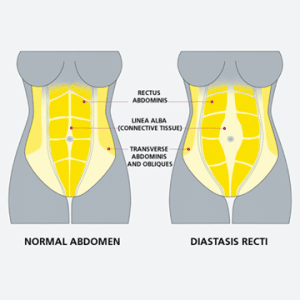The rectus abdominis muscles, better known as the ‘six pack muscles’ of your tummy are linked by a ligament called the Linea Alba.
During pregnancy, the ligament widens to allow space for your baby to grow. By 35 weeks of pregnancy, all women will have a separation of their tummy muscles to create this space. It may happen sooner than this. This is called divarication or diastasis of the rectus abdominis muscles (DRAM). This is a natural and important change in your body during pregnancy.

Visual representation of stomach muscles for a normal abdomen and diastasis recti, as explained in the information on this page.
Because the ligament has widened, you may notice a ‘dome’ or a bulge rise in the middle of your tummy between the rectus abdominis muscles (tummy muscles). You may see it bulge more with movements like getting in and out of bed, sitting up from a lying position or in and out of the bath.
The bulging is simply the pressure in your tummy (which we call intra-abdominal pressure) pushing up against the stretched ligament. It may be sensible to minimise or change movements or tasks that create lots of bulging – for example, rolling onto your side to get in and out of bed in later pregnancy, which is likely what you will be doing naturally.
Holding your breath or bracing when moving can also increase the pressure in your tummy, so keep breathing when doing anything that requires a big effort like lifting, pushing, or pulling.
Managing constipation (difficulty emptying your bowels) in pregnancy is also important. This is because when you are constipated you are more likely to strain, which can also increase the pressure in your tummy. Keeping your poo soft with a balanced diet and fluid as well as sitting in a good position on the toilet can help.
Bowel problems during pregnancy and after childbirthIf you notice a bulge shape, try doing a single pelvic floor squeeze, contracting your tummy muscles or breathing out as you move to see if this makes the bulge smaller. Don’t worry if these make no difference to the shape.
Video: How to do pelvic floor exercises More information about how to do pelvic floor exercisesThere is no single exercise that can prevent DRAM in pregnancy. It is still important to keep your muscles, including your tummy muscles, strong in pregnancy. There is no need to avoid using your muscles altogether. Keeping fit and active during pregnancy has many benefits to your muscles, joints, your health and your baby’s health.
Video: Exercise in pregnancy More information about exercise during pregnancy